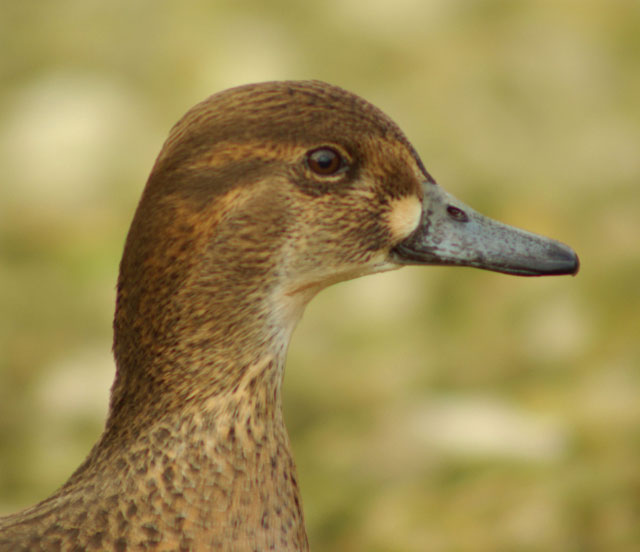
1st-winter female Baikal Teal in captivity (Slimbridge, Glos, January): Hopefully careful scrutiny of autumn and winter 'Teal' flocks will reveal more examples of Baikal Teal occurring in Britain, and maybe some claims of juvenile/female Green-winged Teals. The face pattern may be useful, but is better considered in conjunction with the speculum pattern and shape and other subtle plumage and structural differences to be sure! (photo: Martin Garner).
Is it THE vagrant that is most easily overlooked in the UK? With around 25 records of drakes per year, the presence of unidentified, and overlooked, Green-winged Teals in female, eclipse and immature male plumages has to be assumed. In a comparable species, the Blue-winged Teal, the drab females and immature plumages outnumber records of stunning adult males in breeding plumage in the UK.
There has been the occasional whiff of possible female Green-winged Teals whenever a female clearly accompanies a drake. For example, a female accompanied a drake Green-winged Teal at Flamborough Head briefly in late April 2005. Unfortunately both birds only stayed a few minutes before being flushed and the female was hardly looked at (there were no other Eurasian Teal in the area).
The Asian Baikal Teal is also, unequivocally, an occasional vagrant to the Western Palaearctic. Though most males are straightforward enough to identify, the potential for females and juvenile males to slip through unnoticed seems self-evident.
Learn the speculums!
The following text will focus on various aspects of separating these birds in their less distinct juvenile and female plumages. Many of the plumage, bare part, and structural differences are subtle and must be covered in some detail. However, an easier aspect of the plumage well worth learning is that of the colourful speculums. In many cases, with practice, the differently patterned speculums provide one of the easiest ways of identifying difficult-looking individuals.
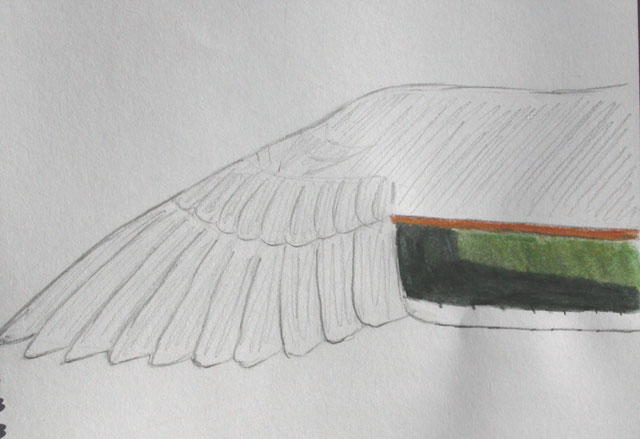
Baikal Teal: Sketch illustrating the speculum of 1st-winter female Baikal Teal. The speculum is much narrower than on Green-winged/Eurasian Teal. There is a particularly thin, solidly coloured, cinnamon brown upper border and long thick block of white along the trailing edge. The green in the speculum is rather bronzy and can at times 'merge' with the black (depending on the light) and be hard to discern (illustration: Emily and Martin Garner).
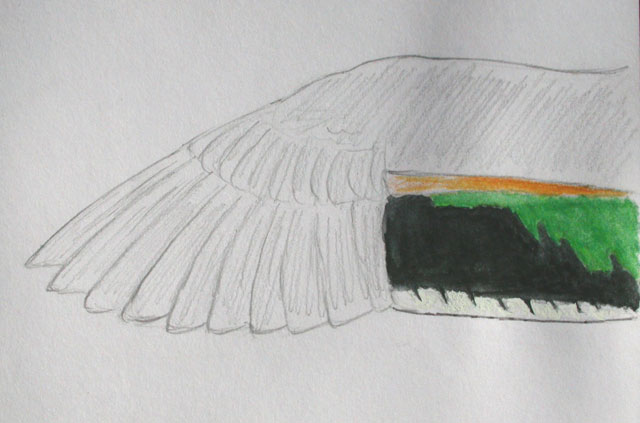
Green-winged Teal: The speculum is obviously broader than on Baikal Teal. Compared to Eurasian Teals, Green-wings in all plumages tend to have thinner upper border to the speculum with more extensive orange on many. Young females also have the broadest amount of white on the trailing edge of the wing and to some extent the pattern can mimic that of young female Baikal Teal, though with care there are clear differences (illustration: Emily and Martin Garner).
Structure
Baikal Teal is not dissimilar in head and bill size to Eurasian and Green-winged Teal; the bill of Baikal Teal averages just over 1 mm longer* and is slightly thinner. The head is sometimes described as being squarer and more peaked at the rear crown ("fuller-naped and thicker-necked" - Eldridge and Harrop 1992). The most obvious structural difference is in body length. This is particularly apparent at the rear end and Baikal Teal normally look obviously longer-bodied, longer-winged** and especially longer-tailed than Eurasian/Green-winged Teal.
- * bill of female Green-winged Teal 34.2-36.1 mm; female Baikal Teal 36-38 mm (Palmer 1976)
- ** wing chord of female Green-winged Teal 185-189 mm; Baikal Teal 201-214 mm (Palmer 1976)
Scapular Feathers
The scapular feathers on any individual dabbling duck vary in shape and size to some extent, but certain overall differences are apparent when looked for. Juvenile and female Baikal Teals, broadly speaking, have feathers that are typically plain-centred and pointed. Green-winged and Eurasian Teals, on the other hand, have scapular feathers that are typically rounded and obviously marked with pale buffy bars internally. Juveniles are a bit more complicated with some overlap in shape and pattern. In juvenile Baikal Teal many scapular feathers are short and rounded; moult into 1st-winter plumage leads to the appearance of more pointed feathers. On adult females the scapulars are, on average, longer and are more obviously pointed. Some individuals even have very long, lanceolate scapulars (as on adult males). Furthermore the scapulars are normally plain-centred on Baikal Teal, or with a simple pattern of a single buff internal cross bar, which is usually not as obvious as on most adult female Eurasian/Green-winged Teal. Eurasian and Green-winged Teals are almost reversed in development of the feather shape. In juvenile plumage the feather is rather plain, rather short, and slightly pointed on some (thus closer to some juvenile and female Baikal Teal). In subsequent plumages the scapulars are slightly longer (though shorter-looking than in Baikal Teal) and rather round-ended feathers with obvious internal orangey-buff wavy crossbars and crescents.
Rump and Back Pattern
In female Baikal Teal the upper tail coverts have dark centres and paler buff fringing. This produces a dark 'band' between the rump and tail, the back and rump pattern consisting of relatively plain pale brownish-grey feathers (with faint paler fringing in young birds). In female Eurasian/Green-winged Teal the appearance of the back and rump is quite different. Essentially it consists of blackish feathers (sometimes with paler internal marks) with obvious pale greyish fringes, producing a 'scaly' or 'scalloped' effect.
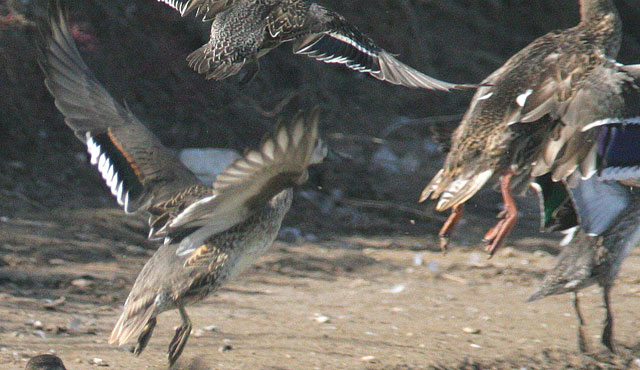
Ducks take flight (Happy Island, China, October): This is a great shot, especially as the head patterns of three different species of duck are not visible. In some ways it is easier to identify them on this view than attempting to unravel the subtle, and variable, features of pale and dark buffy marks around the face. The lower left bird is a female Baikal Teal (probably young bird?) with a female Eurasian Teal above it and a female-type (?) Mallard to the right (with give-away orange legs and feet). Notice the obvious black scaly patterning on the Eurasian Teal, compared with the smooth paler-brown back of the Baikal Teal. In particular make use of studying the all the differences in the speculum patterns (for more see text), which help identify the species (photo: Ian Fisher) .
Speculums
A useful aid to identification involves the shape, and pattern, of the speculum. In Green-winged and Eurasian Teals there are important age-, and sex-, related differences in the speculum pattern.
1) Width of the speculum
This is a crucial point. There is variation in the arrangement/structure of the upperwing feathers within the genus Anas and in different species this affects the width of the speculum. The most obvious example of this is between Eurasian Teal and Garganey. In Garganey the white-tipped greater coverts are much closer to the trailing edge of the wing than in Eurasian Teal so the speculum on a Garganey is obviously narrower than on a Eurasian Teal.
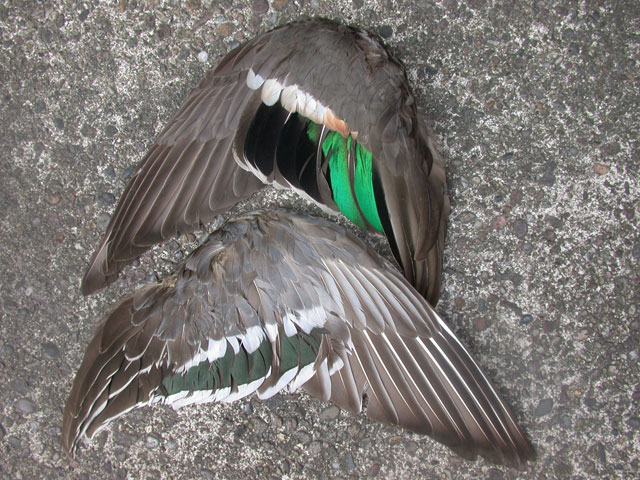
Male Eurasian Teal above and male Garganey below: The speculum is much narrower on the Garganey and there are genuine differences in the size/structural arrangements of the feathers within the different species of Anas, which, when understood, can aid identification. The differences can be most apparent when the wing is closed and speculum just sufficiently exposed to judge width/size (photo: Martin Garner).
The same is true for female Baikal Teal. The greater coverts are closer to the trailing edge so the speculum on female Baikal Teal is considerably narrower than on a Eurasian and Green-winged Teal. This can, admittedly, be difficult to ascertain on flying birds. However, when at rest (in profile), it is relatively easy to assess the speculum width relative to the rest of the wing.
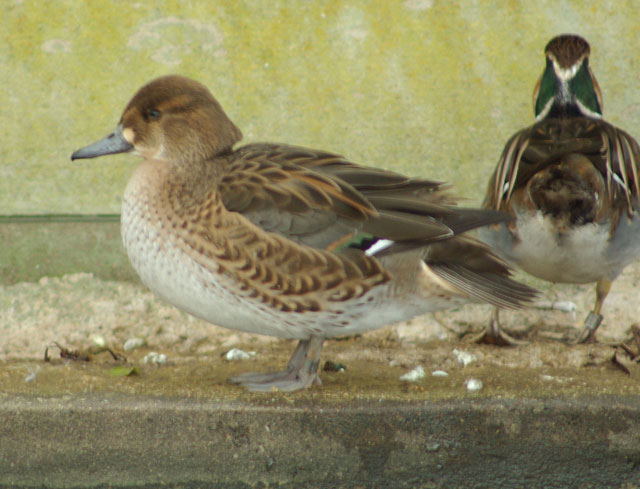
1st-winter female Baikal Teal in captivity (Slimbridge, Glos, January): The folded wing at rest has opened slightly revealing the speculum. In such a pose it is easy to see that the speculum of Baikal Teal is clearly thinner than the broader speculum of Green-winged and Eurasian Teal. Some of the pattern is also discernible: a thin cinnamon-brown upper bar and broader neat white trailing edge (photo: Martin Garner).
2) Upper border to the speculum
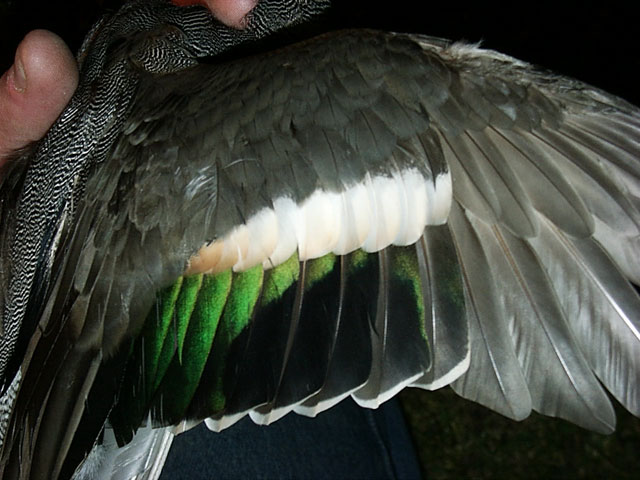
Drake Eurasian Teal: Obviously a male with the grey and black vermiculated scapulars visible, but the speculum also conveys a lot of information. The wedge-shaped white upper border is wider and more extensively white than most male Green-winged Teal and typical of adult males of both species. The rear white border is very thin. Notice how there is 'Teal green' present on every one of the 10 secondary feathers (photo: Steve Huddleston - Wheatear.biz).
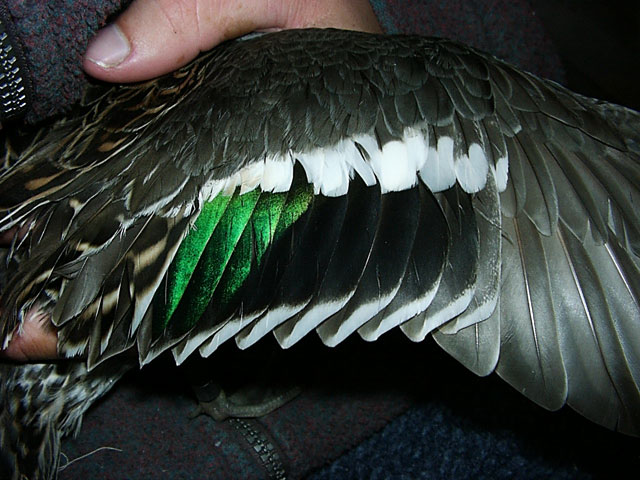
Adult female Eurasian Teal: Again the view of scapulars helps! Brown-barred feathers indicate a female, most likely an adult as first-year females tend to have plainer-centred scapulars. The speculum has a rather broad wedge-shaped upper border that is almost all white, and the trailing edge is broader than the adult male with a block of bright 'Teal green' only on the inner section of the speculum. The shape makes it most likely to be a Eurasian bird (photo: Steve Huddleston - Wheatear.biz).
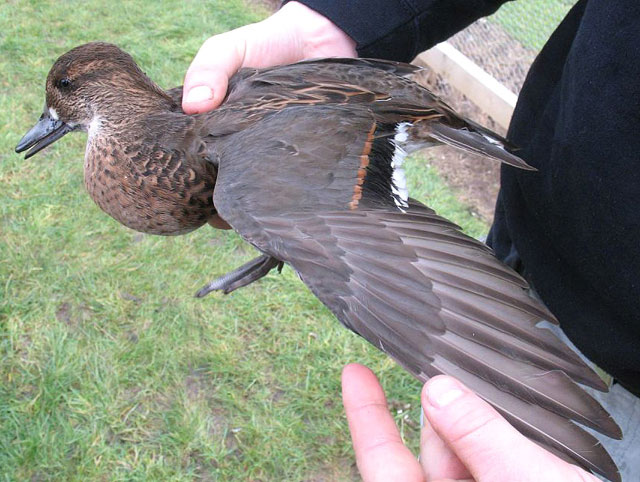
1st winter female Baikal Teal in captivity (Slimbridge, Gloucester January): This shows how distinctive the pattern of Baikal Teal speculums can be. It is clearly a thin speculum with a thin upper border fully saturated with colour and the rear border looks rather broad and solidly white. Green tones present in the speculum are obscured at this angle and are only just visible in the dark central area of the speculum. The speculums on Green-winged and Eurasian are never this thin and the difference in pattern on the speculum, with good views, should be obvious (photo: John Martin).
The pale tips of the greater covert feathers form a bar which creates the pale upper border of the speculum. On female Baikal Teals this pale bar is a solid deep cinnamon-orange/brown colour. The bar is normally obviously thin and of even colour and width all along its length. In Eurasian Teal the greater covert bar is obviously different compared to Baikal Teal. It varies according to age and sex, but is typically quite extensively white, broader and often more wedge-shaped as it broadens from the inner to outer section of the greater coverts. It is thinnest, and of most even width, in young females and broadest, and most wedge-shaped, in adult males.
Green-winged Teals have average differences in this character from both Baikal Teals and Eurasian Teals when like for like (in terms of age and sex) are compared. In general the upper border of the speculum on Green-winged Teal is thinner and of more even width along its length than on Eurasian Teal. Average colour differences in the greater coverts bar have long been documented (Phillips 1923; Schioler 1925). Green-winged Teals in all plumages having more cinnamon-orange present in the greater covert bar than Eurasian Teal (9 out of 10 birds identifiable according to Phillips 1923). However the thinner, and more even, width of the greater covert bar of Green-winged Teal compared to Eurasian Teal has not previously been well documented. In reality it can be a significant difference at all ages including adult males. This would seem to be another useful character in the identification of vagrant 'Teals' in general. The differences become very apparent when comparing flight shots of Eurasian and Green-winged Teal. In a flock of Eurasians many of the birds will show a rather broad wedge-shaped upper border to the speculum. It appears mostly whitish and obviously broader than the white trailing edge. However in a flock of Green-winged Teals the upper borders are thinner and produce a more parallel pattern with the similar width of the white trailing edge.
It is important to note the overlap in the colour of greater covert bar between Green-winged and Eurasian Teal. Some Green-winged Teals show a very similar amount of white to Eurasian Teals in similar plumage (see images by Noel Wamer) rendering it particularly difficult to identify female Eurasian Teal in a North American context (nevertheless most of the speculums on this website still have some orange tones on the greater covert bars and these are narrower, and more parallel-sided, than on many female Eurasian Teal).
3) White trailing edge to speculum
All three species have a white trailing edge to the speculum. The exact shape of white on each feather tip affects the width and overall appearance of the white trailing edge. The amount of white also varies with the age and sex of the individual. For Baikal Teal adult males have the broadest white trailing edge (more like a prominent long rectangular block of white on the rear wing in some, cutting well up into the speculum); conversely in Eurasian and Green-winged Teals it is the immature females that have the broadest white and adult males have the least white.
In female Baikal Teal the upper edge of the white tip of each secondary feather is more squared off, or even convex. The overall effect is of a more solid 'block' of white with a straight-looking line along the upper edge. This long 'block' of white is usually obviously wider than the cinnamon-brown greater covert bar by as much as 2-3 times.
On Green-winged and Eurasian Teals the white tip of each feather is, on average, more concave-shaped (with much less white on the inner web) creating more of a 'U' shape of white at the feather tip. This results in a slightly more wavy upper edge to the white. Green-winged Teals have, on average, a slightly broader trailing edge than Eurasian Teal of the same age/sex (Scott 1999, personal observation). The combination of a narrower, richly coloured, greater covert bar and broader white trailing edge means that some female Green-winged Teals (particularly immatures) have a white trailing edge that is broader than the greater covert bar and so superficially similar to the pattern on female Baikal Teal. In reality the distinctive differences in speculum between Baikal Teal and Eurasian/Green-winged Teal patterns are not too difficult to discriminate between once the patterns are properly understood.
4) Pattern of green and black in speculum
On female Baikal Teal the green and black pattern runs close to being parallel. The upper and lower borders of the speculum broaden only gradually, and slightly, toward the inner section of the wing. The result is that the inner secondaries still have an obvious broad portion of black subterminally to the white feather tip. The green colour is often a slightly darker bronzy-green (making it harder to see) and it extends to being present on about 6 to 9/10 secondaries. Birds with only 6 green-marked secondaries are probably immatures and have very restricted green on the inner secondary feathers.
On Eurasian and Green-winged Teal the variation in the green and black pattern varies considerably. The brighter 'Teal green' colour (sometimes looks metallic blue) typically forms a block of green on the inner side of the speculum that peters out towards the mid-speculum. The number of green-marked feathers varies from 3 to 9/10 (contra BWP). Some aspects of variation can be quantified around age and sex: adult males have the most green and immature females have the least green. More specifically the inner feathers can have from none (adults) to quite a margin of black subterminally on the inner secondary feathers (most often immature females). There are, apparently, no obvious differences in the black and green patterns between Green-winged and Eurasian Teal.
Bare Parts
Female Baikal Teal has a dark grey bill, which is bluer-toned towards the base. Eurasian and Green-winged Teal have slate-coloured bills, usually with pinkish/orange/yellow to varying degrees at the base and some with dark spotting. It has been suggested that an average Green-winged Teal may have less colouring at the bill base than Eurasian (Millington 1998).
Leg colour of female Baikal Teal is described as bluish or yellowish-grey (Phillips 1923). On young birds the legs appear to vary, with some being flesh coloured (personal observation, Eldridge and Harrop 1992)
Leg colour in Eurasian Teal varies from olive-grey to grey-brown (BWP), grey-green to drab (Witherby et al.) or greenish- to brownish-grey (Phillips 1923), being on average typically greyish. Green-winged Teal has paler legs than Eurasian Teal, described as darkish, lead-coloured to olive-greenish (Palmer 1976) and pale brown to grey-fawn (Witherby et. al.). A search of photos on the Internet reveals that many Green-winged Teal have obviously pale legs, ranging in colour tone from olive-green through flesh even to yellowish.
Underwing
Differences in underwing pattern between Baikal Teal and Green-winged/Eurasian Teal are slight. Differences are most obvious in fresh plumage (autumn) when the smaller underwing coverts are uniformly dark on Baikal Teal versus pale-fringed dark on Green-winged/Eurasian Teal. All three species show contrast with the rest of the paler underwing, particularly a whitish mid-wing bar/panel (greater underwing coverts). However, with wearing of pale fringes through winter to spring the underwing of Green-winged/Eurasian Teal becomes progressively more similar to that of Baikal Teal.

1st-winter female Baikal Teal in captivity (Slimbridge, Glos, January): The underwing of Baikal Teal has plain dark smaller underwing coverts which contrast with a whitish band of under greater covert and pale underwing as a whole (photo: John Martin).
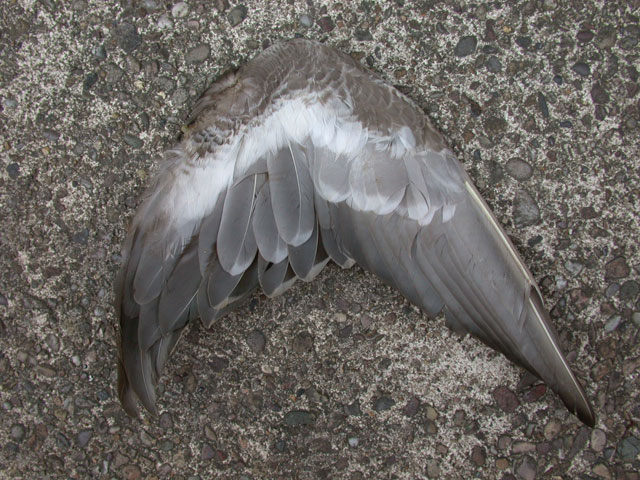
Adult male Eurasian Teal from the mid-winter period: In fresh plumage (autumn) the underwings of Green-winged and Eurasian Teal differ from Baikal Teal in having obviously pale fringing to the dark smaller underwing coverts, but with wear through the year and this difference becomes considerably less useful (photo: Martin Garner).
Facial Pattern
On adult female Baikal Teal a bright white loral spot, emphasised by a dark surround and bright white chin and throat, typifies the facial pattern. A white vertical spur (variable in its conspicuousness) extends up from the throat towards the eye. About 15% of females, according to Palmer; also have a dark line running from the gape and forming a bridle (but it can be broken and inconspicuous (Eldridge and Harrop 1992)). The rest of the head pattern is relatively subdued and there is not normally such an obvious dark cheek stripe as on female Garganey and some Green-winged Teals. A thin line between bill base and eye and broader supercilium behind the eye tend to be quite deep cinnamon-buff and add to the cryptic face pattern. The white loral spot can be somewhat obscured in summer and the full distinctiveness of the face pattern is reduced at distance with only the loral spot being outstanding (Eldridge and Harrop 1992).
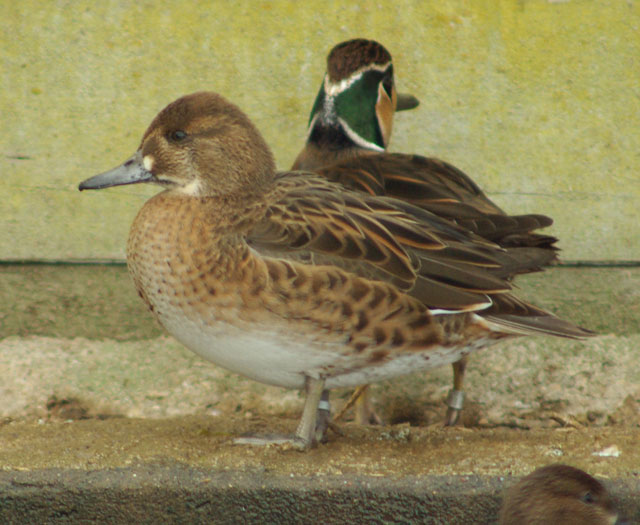
1st-winter female Baikal Teal in captivity (Slimbridge, Glos, January): Apart from the rather bright white loral spot, which looks a little incongruous compared to the rest of the face pattern, notice the rich rusty tones present on the face and body plumage. The bill is clearly bluish at the base and in direct comparison, a little longer-billed and definitely longer-bodied than Green-winged and Eurasian Teals (photo: Martin Garner).
In the juvenile plumage of Baikal Teal, the facial pattern can be closer to some congeners with a more conspicuous Garganey-like cheek stripe on a greyer face and an absence of the white spur. However, the white loral spot is still usually conspicuous. Some juveniles can have a remarkably similar face pattern to some female Teals (particularly Green-wings).
Eurasian Teal, usually, have a much more subdued pattern, lacking the bright whites of the loral spot, throat and spur found in Baikal Teal. They have a much simpler pattern of buff and grey-brown tones broken by a weak dark eye-stripe and paler supercilium. There is some variation, with some birds showing slightly stronger face patterns such as a weak cheek stripe, vague pale spur and pale loral spot but not normally to the extent of adult female Baikal Teal.
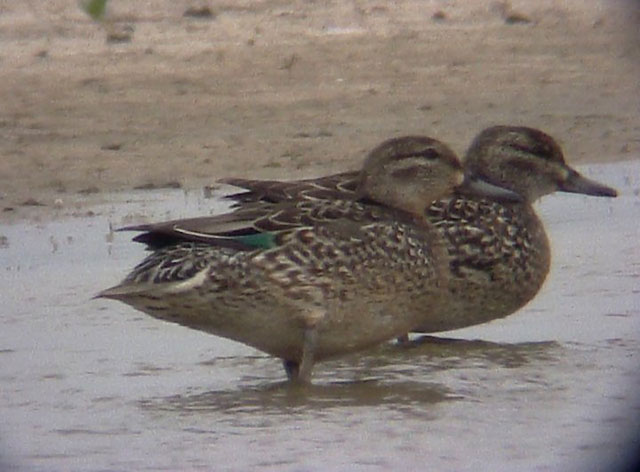
Female Green-winged Teal (Texas, April): Note the spring face pattern with dark cheek stripe and prominent pale loral spot (photo: Ian Lewington).
Female Green-winged Teal vary somewhat more than Eurasian Teal. Some have a very similar facial pattern to Eurasian Teal; many have a much stronger facial pattern including prominent pale loral spot and strong Garganey-like cheek stripe as first indicated by Millington (1998) and occasionally a pale spur (see here for examples). Indeed, well-marked birds are sometimes mistaken for Garganey by North American birders. A prominent pale loral spot has long been known as a feature of Green-winged Teal. Schioler (1925), who illustrated all the Eurasian/Green-winged Teal plumages in great detail, painted a female Green-winged Teal with striking face pattern of a kind that would be unfamiliar to British observers (see below). Palmer (1976), in the description section on female Green-winged Teal, writes:
"... quite often with unmarked circular white area at side base of bill (such as is typical of the female Baikal Teal)."
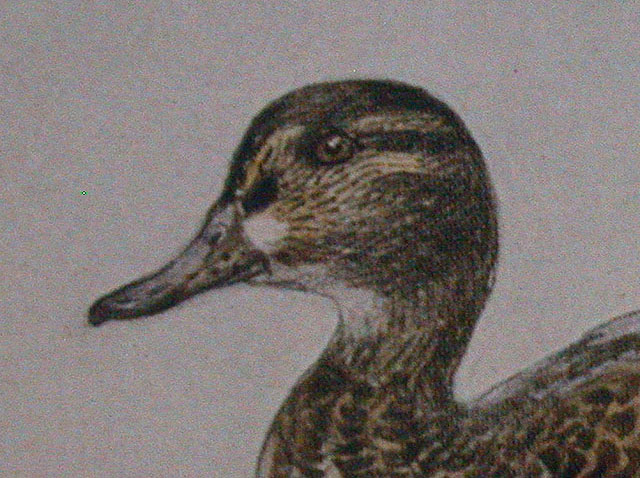
Green-winged Teal: This illustration of a female Green-winged Teal shows just how striking the face pattern can be on some individuals. This illustration is part of a plate in a book by Schioler whose wildfowl artwork is acclaimed as some of the most accurate ever depicted. With only five copies of the book left anywhere in the world, it's not easy material to access! (photo: Martin Garner, copyright NHM).
However, when considered more carefully, the loral spot and chin/throat region on Baikal Teal are generally brighter white. These, with the white spur, are incongruent patterns compared with the rest of the head plumage with its rich, almost rusty buffs and browns. When present, obvious pale loral spots on Green-winged and Eurasian Teals tend to be more buff-toned matching the ground colour of the rest of the facial pattern.
Summary of Key Characters
Adult male Green-winged Teal - extra feature
- Narrower, parallel-sided upper border to speculum, which can be mostly orange-coloured (broader, mostly white and more wedge-shaped in Eurasian Teal)
Female/immature Green-winged Teal and Eurasian Teal
Features common to both:
- Short-bodied and compact structure
- Typically rather short, rounded, scapulars with pale internal barring
- Back and rump with scaly appearance due to pale-fringed black feathering
- Speculum broad and covering nearly half of inner wing; obvious at rest
- Bill base variation of pinkish/orange/yellow
- Small underwing coverts blackish with pale fringes when fresh (autumn), more uniform dark when worn (spring onwards)
Features separating these two species:
- Narrower (parallel-sided) and more extensively orange-toned greater covert bar on Green-winged Teal
- Stronger face pattern, more often with pale loral spot and more conspicuous dark cheek stripe on Green-winged Teal
Female/immature Baikal Teal versus Green-winged Teal
- Longer-bodied
- Typically rather long pointed scapulars which are mostly plain-centred
- Back and rump mostly plain brownish-grey
- Speculum narrow covering less than 1/3 of inner wing, obviously thin at rest
- Bill base bluish-grey
- Small underwing coverts always wholly dark lacking obvious pale fringing
- Particularly thin greater covert bar, wholly cinnamon-orange
- White trailing edge often appears on solid block of white
- Facial pattern with bright whitish loral spot usually against background of strong rufous tone to plumage. Beware some Teals; especially Green-wings, can appear confusingly similar especially when comparing fresher juvenile/1st-winter plumages.
For more comprehensive coverage of these three species see Cramp and Simmons, Palmer 1976, Eldridge and Harrop 1992, Millington 1998, Sangster et al. 2001.
Acknowledgements
Many thanks to the following for input and the experience of learning together! Chris Batty, Richard Millington, Noel Wamer, Chris Galvin, Leo Boon, Ian Lewington, Ian Fisher, Chris Kehoe, Nigel Hudson, John Martin, Martin Scott, James Smith, Martin Reid and James Lees.
References
Cramp, S. et al. 1977. Handbook of the Birds of Europe, the Middle East and North Africa. Vol 1. Oxford.
Eldridge, M. and Harrop, A. 1992. Identification and Status of Baikal Teal. Birding World 5:11.
Millington, R. 1998. The Green-winged Teal. Birding World 11:430-434.
Palmer, R. S.1976. Handbook of North American birds. Vol. 2. Yale Univ. Press, New Haven, CT.
Phillips, J.C. 1923. A natural history of ducks. Vol. I. Houghton Mifflin. Boston.
Sangster, George; Knox, Alan G.; Helbig, Andreas J. and Parkin, David T. (2002): Taxonomic recommendations for European birds. Ibis 144(1): 153–159
Schioler, E.L. 1925. Danmarks Fugle 1. Copenhagen: Nordisk Forlag.
Scott, M. 1999. Identification of female Green-winged Teal. Birding Hawaii 12/2. p.81. Norfolk.
Witherby, H. F., F. C. R. Jourdain, N. F. Ticehurst, B. W. Tucker. 1939. The Handbook of British Birds, Vol. 3. Witherby Ltd., London, U.K.




